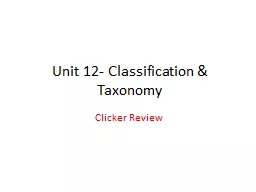

Clicker Review From the following list of common and scientific names determine which pair represents the two most closely related plants Scarlet runner bean and castor bean Potato bean and broad ID: 776336
Download Presentation The PPT/PDF document " Unit 12- Classification & Taxonomy " is the property of its rightful owner. Permission is granted to download and print the materials on this web site for personal, non-commercial use only, and to display it on your personal computer provided you do not modify the materials and that you retain all copyright notices contained in the materials. By downloading content from our website, you accept the terms of this agreement.
Slide1
Unit 12- Classification & Taxonomy
Clicker Review
Slide2From the following list of common and scientific names determine which pair represents the two most closely related plants.
Scarlet runner bean and castor beanPotato bean and broad beanKidney bean and scarlet runner beanCastor bean and kidney bean
[Default][MC Any][MC All]
broad bean = Vicia fabacastor bean = Ricinus communiskidney bean = Phaseolus vulgarispotato bean = Apios americanascarlet runner bean = Phaseolus coccineus
Slide3The classification level in which classes with similar characteristics are grouped are called a(n)
TaxonomyPhylumOrderClass
[Default]
[MC Any]
[MC All]
Slide4The Science of classifying organisms and assigning each organism a universally accepted name is called
taxonomyphylumtaxonbinomial nomenclature
[Default][MC Any][MC All]
Slide5single-celled, heterotrophic, motile, no cell wall
AnimalProtistFungiPlant
[Default][MC Any][MC All]
Slide6Which of the following is the correct scientific name of an organism?
E.
Coli
Canis
lupis
Saccharum
Grant's
gazelle
Slide7Who developed the 2-words naming system for classification in the 1700s that is still used today?
Jean-Baptiste Lamark Stanley MillerCarolus LinnaeusCharles Darwin
[Default][MC Any][MC All]
Slide8According to our modern system of classification, the organism called Bacillus cereus would be most closely related to
Cereus bacillusStrigiformus bacillusBacillus strigiformusCereus strigiformus
[Default][MC Any][MC All]
Slide9When using binomial nomenclature an organism is named by its
kingdomgenus and speciesphylum and classmode of reproduction
[Default][MC Any][MC All]
Slide10Which of the following correctly matches the cell wall descriptions of each kingdom?
Plantae – Chitin, Archaebacteria – Peptidoglycan, Fungi – CellulosePlantae – Cellulose, Eubacteria – Peptidoglycan, Fungi – ChitinPlantae – Peptidoglycan, Fungi – Chitin, Protista – CellulosePlantae – Cellulose, Archaebacteria – Peptidoglycan, Protista - Cellulose
[Default]
[MC Any]
[MC All]
Slide11a branching diagram that represents the proposed phylogeny or evolutionary history of a species or group.
Binomial nomenclature Cladogram Taxon Taxonomy
[Default]
[MC Any]
[MC All]
Slide12Prokaryote with cell walls made of peptidoglycan
ArcheabacteriaEubacteriaProtistaFungiPlantaeAnimalia
[Default]
[MC Any]
[MC All]
Slide13All members are heterotrophs lacking a cell wall
ArcheabacteriaEubacteriaProtistaFungiPlantaeAnimalia
[Default]
[MC Any]
[MC All]
Slide14Composed of all autotrophic eukaryotes
ArcheabacteriaEubacteriaProtistaFungiPlantaeAnimalia
[Default][MC Any][MC All]
Slide15A group of related classes is
KingdomsTaxonOrderPhylum
[Default][MC Any][MC All]
Slide16group or level of organization into which organisms are classified
TaxonomyClassTaxonDomain
[Default]
[MC Any]
[MC All]
Slide17Eukaryotes with cell walls made of chitin
ArcheabacteriaEubacteriaProtistaFungiPlantaeAnimalia
[Default]
[MC Any]
[MC All]
Slide18Eukaryotic that are mostly unicellular, but may be multicellular, some are autotrophic & some are heterotrophic
ArcheabacteriaEubacteriaProtistaFungiPlantaeAnimalia
[Default][MC Any][MC All]
Slide19A genus is made up of related
FamiliesSpeciesDomains Classes
[Default][MC Any][MC All]
Slide20All unicellular with cell walls that do not have peptidoglycan and live in extreme places
ArcheabacteriaEubacteriaProtistaFungiPlantaeAnimalia
[Default]
[MC Any]
[MC All]
Slide21Non-motile eukaryotes with organs and organ systems
ArcheabacteriaEubacteriaProtistaFungiPlantaeAnimalia
[Default][MC Any][MC All]
Slide22What trait separates sharks from ray-finned fish on this cladogram
Vertebrae Amniotic eggHair Bony skeleton
Slide23What separates rabbits and primates from amphibians on this cladogram
Eggs with shellsAmniotic eggHair 4 limbs
Slide24Prokaryotic decomposeres
Archeabacteria
Eubacteria
Protista
Fungi
Plantae
Animalia
Slide25Which organism is most related to the bird on this cladogram?
Rodents & rabbitsCrocodiles Sharks Primates
Slide26Heterotrophs with organs and organ systems
Archeabacteria
Eubacteria
Protista
Fungi
Plantae
Animalia
Slide27How to make a Dichotomous Key
https://
www.youtube.com/watch?v=AZoNcmogEug
Slide28Answers
C B A B BC C B B B B F E D C
16. D
17. C
18. B
19. A
20. E
21. D
22. C
23. B
24. B
25. F